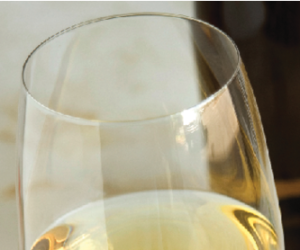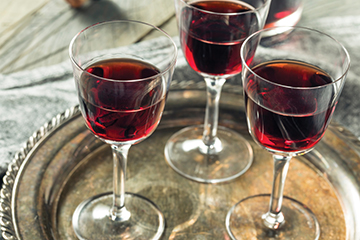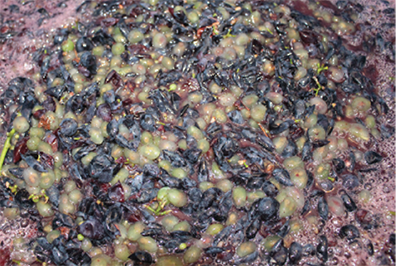 Wine, grapes, yeasts, and aromatic compounds are all very temperature-sensitive, and the temperature a wine is fermented at can have a significant effect on the resulting wine’s style. The same must fermented at different temperatures, treated otherwise identically, can result in very different wines, particularly in their youth.
Wine, grapes, yeasts, and aromatic compounds are all very temperature-sensitive, and the temperature a wine is fermented at can have a significant effect on the resulting wine’s style. The same must fermented at different temperatures, treated otherwise identically, can result in very different wines, particularly in their youth.
Fermentation temperatures have an effect on the yeast, on the must, and the wine itself, and on extraction with reds (and skin contact whites, to include everybody). Beyond keeping your yeast alive by maintaining temperatures between 50–85 °F (10–29 °C) (pretty much the range we humans are comfortable in, too!), the temperature you choose for your fermentation, if you can control it, is mainly a stylistic one.
Fermentation generates its own heat (it’s what’s known as an exothermic process), and unless the rate of heat dissipation can match or exceed the rate of heat production by the yeast, temperature will rise. The extent to which the temperature can rise in a fermentation is a result of the quantity of the energy source from which the heat is produced: Sugar. The great Emile Peynaud gives us the formula that the fermentation of 100 grams of sugar has the potential to raise the temperature of a liter of water by 55 °F (30 °C) (if no heat is lost). As 100 grams of sugar in a liter of water roughly equates to only 9.5 °Brix, you can see how powerful this force can be. As a home winemaker, temperature control isn’t always easy (or cheap), but we’ll review a few good options at the end of this article.
Yeasts’ temperature sensitivity varies by genera, species, and strain, but care should always be taken to avoid going beyond the extremes mentioned earlier. Within this range, the cooler the fermentation, the slower a yeast cell will work. The warmer the fermentation, the faster it will work. A related fact is that different yeasts will ferment slower or faster relative to one another at the same temperature (in other words, there are faster and slower fermenting yeasts), which also factors into a fermentation’s pace. Information on a yeast’s preferred temperature range and speed (and much more) is available online or by calling your yeast manufacturer.
With spontaneous (wild, native, or feral) fermentations, heat will build slower at the outset, as the yeast will take longer to multiply and establish themselves, relative to inoculation with a larger, healthy population that’s ready to go. (A pied de cuve — a French term that means “base stock” and involves starting a native fermentation with grapes harvested early prior to harvest — can jumpstart a spontaneous fermentation, but that may not be an option for all home winemakers.) Not knowing what mix of yeast and bacteria are carrying out your fermentation, you won’t know what to expect of your fermentation’s pace, however, spontaneous fermentations may go significantly slower, accumulating less heat, than inoculated.
Cooler Fermentations
If you are fermenting in a cold cellar, or getting a bit heavy handed with cooling methods, at around 45 °F (7 °C), your yeast will shut down and possibly die. Harsh, but not as harsh as what can happen if you let things get too hot, as you’ll see! A producer I import, Charlotte Allen of Bodegas Almaroja in the Arribes Denominación de Origen (DO) of Spain, used to make wine 150 feet (46 m) into a 500-year-old cave; very picturesque, but she often had to drag in space heaters on extension cords to keep her fermentations from stopping! So, the good news is that if it’s too cold, it’s not too difficult to get the yeast to wake up and start consuming sugar, it just takes a little heat.
The major risk with yeasts not fermenting (or doing so very slowly), is that without a must saturated with and covered by carbon dioxide, and also dominated by a healthy population of yeast-consuming nutrients and fending off potentially harmful microbiota populations, the must is vulnerable to various types of spoilage. A fermentation that is slow to start from cold is less of a risk than a stuck fermentation later on (not owing to cold) as most bacteria will shut down from cold before yeast, however, the risk is still present.
For a cooler, slower fermentation for whites, around 50–55 °F (10–13 °C) is a safe temperature. Usually only whites are fermented at these temperatures, as they would lead to a greatly diminished rate of extraction in reds. To avoid the risk of a slow start and a vulnerable period, if you have the means, you can cool the must down after the yeast have started going strong.
Cool and slow fermentations are traditionally thought to give greater complexity to a wine, and with the cold cellars of German Rieslings creating such cool fermentations that can go on for months, who are we to argue? However, it is unclear what specifically would cause this added complexity, perhaps simply a greater abundance of various byproduct compounds from the yeasts, owing to the longer time they are working.
Another possible explanation is that at such cold temperatures, you will have a much fruitier wine in its youth. Here, aroma compounds known as esters are best retained. Esters are a large and diverse group of related compounds, responsible for many of the fruity and floral aromas in young wines, like banana, pineapple, green apple, rose, and many more. The concentration of esters greatly diminishes during the first few months and years in bottle. Interestingly, more (and longer-lived) esters are actually produced at higher temperatures, but at these same higher temperatures, where there is also more active and vigorous fermentation, more esters are also lost to volatilization. As an aside, it seems that esters volatilizing at higher temperatures would be beneficial to a vine. Most fruit ripens in the warmer months, when more animals are out and about, and what good would a nice, fruity ester be to a vine if it couldn’t float off into the air (volatilize) to draw in these animals to eat its grapes and disperse its seeds?
It’s worth noting that many mass-produced, highly-fruity white wines are made using the recipe of highly-clarified must that sees very little oxygen, is fermented cold, and is inoculated with yeast strains known to produce high amounts of esters. These types of yeasts and wines may be one of the reasons that the benefits of using commercial yeasts were suspect in certain winemaking circles.
Warmer Fermentations
Let’s jump to the hotter side of the spectrum. To create softer, fuller wines, temperatures between 75–85 °F
(24–29 °F) are often preferred for fermenting reds. A hotter, faster fermentation means more efficient extraction of color and tannin from the skins. As the entire fermentation will go faster, all stages of fermentation will happen faster as well, including the final stage of fermentation when the highest level of alcohol is present, and so a winemaker can minimize extraction of seed tannins, which require alcohol for their liberation. Tannin is much more abundant in seeds than skins, and, seed tannins are believed by many to be more astringent, though whether or not they actually are is disputed. Regardless, a hotter, faster fermentation will help you avoid seed tannin, which, astringent or not, means less overall tannin, and can leave you with a softer, lusher red wine.
At these higher temperatures, more polysaccharides are extracted, which increase softness and fullness of a wine’s mouthfeel. Polysaccharides are a group of carbohydrates, (don’t fear, there is less than a single calorie per bottle!). They are extracted both from grape skins and from dead yeast cells, which autolyze faster at higher temperatures (some wineries actually practice a warm extended maceration for this purpose). Also, more glycerol is produced at higher temperatures, which can increase the sensation of sweetness.
Higher temperatures are more efficient for extraction and go faster, taking a week or two. The reason for the increase in the speed is twofold: Yeast metabolizes faster at warmer temperatures, and multiplies significantly faster at higher temperatures; so you have more yeast, consuming faster. This, however, does come with its problems. A fermentation much above room temperature — though it will increase the yeasts’ metabolism and speed — will also shorten their lives. They gulp down lots of sugar fast, but meet an early demise (life in the fast lane, think Jim Morrison and Janis Joplin.) This can lead to the dreaded stuck fermentation at the end of a fermentation, as the yeast simply give out, leaving your wine and its remaining sugar unprotected from spoilage microbiota.
Another risk with hotter fermentations is that heat-stressed yeast may also produce stinky, sulfury, off-aromas (hydrogen sulfide, which can lead to mercaptans) and certain types of esters (acetate esters) that smell similar to nail polish. If caught early, a good splash racking can solve this. Again, yeast are similar to people: When it’s hot out, we don’t always give off the best aromas.
White wines fermented at these temperatures are thought to lose some of their more delicate aromas (as with the esters). Their absence, of course, isn’t anything one can perceive from tasting the wine, and I’ve made whites that I’m very proud of that have gotten into the 80s °F (~30 °F). However, you’ll always be left wondering what could have been.
Likewise, I believe that despite the benefits from more efficient extraction with reds, they too probably lose some delicacy from fermentation at such high temperatures (after all, red wines are white wines, with the addition of what’s in the skins and seeds). That being said, depending on your goals, what you may gain in mouthfeel from these temperatures may justify a loss of aroma.
Ideal Temperatures
The usual goal for quality white wine fermentations is 60–68 °F (15–20 °C). As less esters are retained, the resulting wine is generally considered more a product of the grapes themselves, rather than of generic, yeast-produced, aromas. Certain aroma precursors, bound up in the grapes themselves, are more efficiently liberated and converted to volatile (and therefore smellable) forms by yeast at warmer temperatures as well — thiols (responsible for Sauvignon Blanc’s characteristic passion fruit and cat pee aromas) being a key example.
Not being too hot or vigorous, aroma compounds are better retained and there is less risk of the production of off-smelling sulfur compounds. For the same reasons, 65–75 °F (18–24 °C) is a great temperature for reds, also allowing for more time on the skins and seeds for extraction.
From the angle of preserving or demonstrating terroir, or what is unique about a vineyard site, these middle-ground temperatures for reds and whites seem to be ideal: Maintaining the more grape-derived aromas without adding as many non grape-derived aromas (fruity esters, or hydrogen sulfide and acetate esters) and allowing for the extraction of the full variety of present tannins.
I think it’s worth noting that part of what is often sought after from picking early (more delicate and diverse aromas) can be potentiated by fermenting in this mid-range of temperatures, and those which are sought after from picking later (softer tannins, lusher body) can be potentiated by hotter fermentations.
Controlling Temperatures
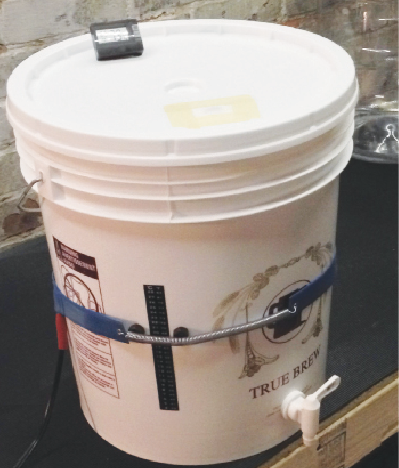
There are many tricks and tools home winemakers can use to adjust a wine’s fermentation temperature to their preferred range.
Warming is much simpler than cooling. As noted earlier, a space heater can take care of this. You could also wrap your fermentation vessel in an electric blanket or some insulating material. Heat pads, aquarium heaters, heated belts (as shown on at left) or electric wrap are other fairly simple options.
For cooling, it gets more complicated, but there are many options. A crucial way to start off on a cool foot is to bring your fruit in cold (nighttime or early morning picks if possible, or even a refrigerated truck). Starting off cooler slows down temperature rise significantly. It also slows the onset of fermentation, so with reds you get a bit of a free cold soak. Of course, as a home winemaker, perhaps hundreds of miles from the vineyard, this isn’t always an option.
Another simple trick is using dry ice, readily available at the supermarket. At -109 °F (-78 °C), it can cool things off quickly, so don’t go overboard. If you are working with a bucket or carboy, you can submerge it in a tub of water and put the dry ice in the water. Not as immediate or efficient, but I’m sure the yeast wouldn’t mind the gentler decline in temperature. For barrel fermentations, as they retain so much heat due to their small opening and thick walls, short of a cold room, adding dry ice is probably your only simple option.
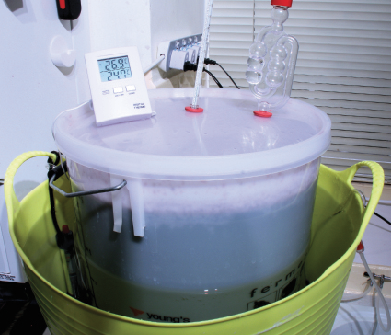
Don’t want to use dry ice? You can also freeze water bottles and place them in the must, or put ice water in a bucket and then place the fermenter in it (as shown at right).
For reds, punching down releases a burst of built up carbon dioxide, and with it, heat. Pumping over cools down your cap (usually the warmest part of red fermentations), but as you are not freeing the gas below it, and you are cooling down a hot cap with warm must, it is a less effective technique for cooling a fermentation than punching down.
Using smaller fermentation vessels can help. Smaller vessels have a lower volume-to-surface-area ratio than larger vessels. In other words, smaller vessels have more surface area (from which to dissipate heat) per unit of fermenting wine. So, a smaller tank can dissipate more of the heat that the fermentation generates than could a larger tank of the same shape and material.
Many wineries use their half-ton and one-ton harvest bins for fermentation. With a large exposed surface, these allow the wine to release heat, but they also have a large opening, from which this heat can dissipate. Heat generated during fermentation is most efficiently dissipated along with the carbon dioxide released during fermentation. Carboys and barrels trap lots of this heat inside, and cannot cool as efficiently as a fermenter with a larger opening, such as a food-grade bucket or trash can, or a stainless tank. You can use a light cheese cloth, essentially mesh, rather than a tighter knit sheet, to cover your fermentation, which will further facilitate heat dissipation. Harvest bins would be too shallow and wide for whites, but the taller, more conical tank options mentioned earlier work well, as they retain more carbon dioxide above the fermenting wine, protecting it. While a white fermentation remains vigorous, the wine is saturated with carbon dioxide and the abundance of CO2 being produced will ensure that most or all of the oxygen outside your vessel, remains outside your vessel. Once fermentation begins to slow, the wine should be racked into a sealable vessel or one with less airspace.
These options discussed so far are all fairly inexpensive, although the significance of their effects is somewhat limited. Depending on your circumstances, you may need to employ more than one of these tricks, or all of them, to keep your fermentation cool.
The ancients made do with these types of techniques for millennia, however, thanks to the advent of refrigeration, we’re now endowed with a range of options that can all but ensure a way to cool down your fermentation. Not only do these delightful technologies allow you to cool fermentations, but they can also allow you to cold stabilize your wines and skip the additives.
If you’re working with smaller volumes of wine and have access to an extra fridge or chest freezer, override thermostats are readily available at winemaking shops for around $60. Installation is fairly straightforward, and each act as a great insulator to protect from external heat or cool spikes. In fact, these would also be good places for aging your wines.
A great option for larger volumes, though a bit more of an investment, would be a glycol chiller. Small glycol chillers can be found for under $1,000; restaurant supply companies often have the best deals. With a chiller you have a few options. If you’re working with a bucket or a carboy, there is a small neoprene covered cooling jacket (the Cool Zone) that mimics the jackets on larger stainless tanks. If you’re working with larger volumes, cooling snakes are great; they are tubes that go directly into the wine, inside of which the glycol circulates to maintain the desired temperature. Some stainless steel tanks for home winemakers also have a built-in jacket or belt to which a glycol chiller can be attached, or ice water can be recirculated through with a pump.
With all of these options available, no matter where you live, you have the ability to control your fermentation temperature. And with that, you have the ability to guide your wine into the style you’d like it to be.



